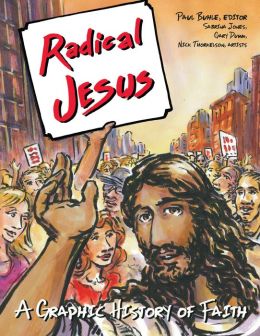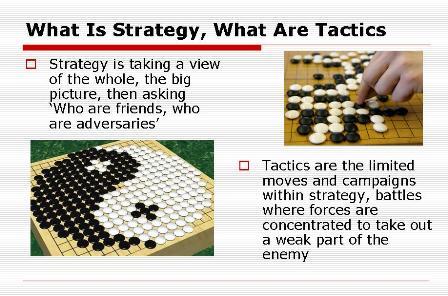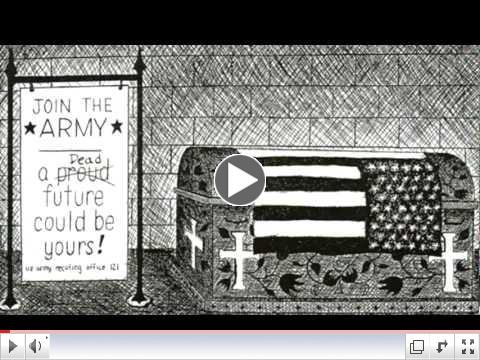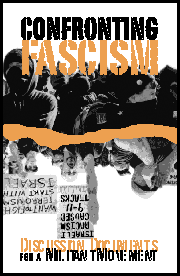 | |
Jack Kerouac Reads
'October in the Railroad Earth'
|
|

NEW CCDS Pamphlet
on Climate Change.
|

New CCDS Book Reporting on Vietnam
|
|
Radical Jesus:
A Graphic History of Faith  By Paul BuhleHerald Press By Paul BuhleHerald Press
|

Want to Know what CCDS has
been doing...Check it Out!
|
 Keep On Keepin' On Keep On Keepin' OnHating the 'Middle Class,' Why Socialists Run in Elections, Strategy and Tactics Slide Slow, Class and Privilege, the Green New Deal ...and other Short Posts on Tumblr by Carl Davidson
|

Edited by Carl Davidson Revolutionary Youth and the New Working Class: The Praxis Papers, the Port Authority Statement, the RYM Documents and other Lost Writings of SDS Changemaker, 273pp, $22.50
For the full contents, click the link and view 'Preview' under the cover graphic.
|
 The new annual edition of our journal of discussion and analysis is now out. More than 170 pages, it includes 14 articles on strategy austerity, organizing, and the right. Cost is $10 plus shipping. Or get one by becoming a sustainer. Click the title to buy it directly. The new annual edition of our journal of discussion and analysis is now out. More than 170 pages, it includes 14 articles on strategy austerity, organizing, and the right. Cost is $10 plus shipping. Or get one by becoming a sustainer. Click the title to buy it directly.
|
|
By Randy Shannon, CCDS

"Everyone has the right to work, to free of employment, to just and favorable conditions of work and to protection against unemployment."
- United Nations Universal Declaration of Human Rights, December 10, 1948
I. Introduction
The "Great Recession" that began in 2007 has caused the greatest percent of job losses since the Great Depression of 1929. This crisis is the end of an era of unrestrained 'neo-liberal' capitalism that became public policy during the Reagan administration. The crisis marks a new level of instability with the growth of a global financial elite that targeted US workers and our trade unions after World War II.
|
|
Order Our
Full Employment Booklets
 |
...In a new and updated 2nd Edition
Capitalism may well collapse under its own excesses, but what would one propose to replace it? Margaret Thatcher's mantra was TINA...There Is No Alternative. David Schweickart's vision of "Economic Democracy" proposes a serious alternative. Even more fundamentally, it opens the door to thinking about alternatives. His may or may not turn out to be the definitive "successor system," but he is a leader in breaking out of the box. |
 by Paul KrehbielAutumn Leaf Press, $25.64
by Paul KrehbielAutumn Leaf Press, $25.64 | | Shades of Justice Video: Bringing Down a President, Ending a War |
|
 By Giuseppe Fiori
Verso, 30 pages
|

Essays on Mondragon, Marx, Gramsci
and the Green and Solidarity Economies |

The Story of Workers Coops
in the Connecticut River
Valley Today.
Coauthors: Janelle Cornwell
(Worcester State University),
Michael Johnson (Grassroots
Economic Organizing Newsletter)
and Adam Trott (Valley Alliance
of Worker Co-operatives and
Collective Copies)
|

- Foreword by Susan Brownmiller
- Preface by Ken Wachsberger
$37.50 + $6 shipping
|
|
Discussion Documents for a Militant Movement

By Don Hamerquist
|
|
|
|
An Invitation to CCDSers and Friends...
 The Painful The Painful
Intersection
of Race, Class
and Gender
We're the Committees of Correspondence for Democracy and Socialism...Do you have friends who should see this? Pass it on...Do you have a blog of your own? Others you love to read every day? Well, this is a place where you can share access to them with the rest of your comrades. Just pick your greatest hits for the week and send them to us at carld717@gmail.com! Most of all, it's urgent that you support low-wage workers, oppose militarized police, the war on Gaza, defend voter rights, plan for 2014 races now, oppose austerity, support the 'Moral Mondays' in North Carolina, the fight for the Green New Deal, a just immigration policy and the Congressional Progressive Caucus' 'Back to Work Budget'! We're doing more than ever, and have big plans. So pay your dues, make a donation and become a sustainer. Do it Now! Check the link at the bottom... |
Maria Fernadez' Final Shift: From Job
To Job To Job, A Life Lived - And Lost

By 'Elizabeth' The Financial Express
Oct 22, 2014 - The fumes, reeking of gasoline, poured from the white Kia SUV as soon as an emergency medical technician broke one of the rear windows. Inside, the body of a dark-haired young woman with a beauty mark on her left cheek reclined in the driver's seat, keys dangling from the ignition.
But who was she? How was it that her life had ended here, in the corner of a convenience store parking lot, less than a mile south of Newark Liberty International Airport's runways?
Waiting for the vapors to clear so they could search her belongings, police noted the most obvious clue: She was wearing a familiar white-and-brown uniform. By that night, co-workers and friends had identified her as Maria Leonor Fernandes, 32 years old and single. She had worked minimum wage jobs at a Dunkin' Donuts shop nearby as well as two others - often grabbing an hour or two of sleep in her car between shifts.
Within days, Fernandes was being mourned as a tragic heroine, a victim of our times. Far beyond the Newark neighborhood where she rented a basement room with bath for $550 a month, her death became fodder for online commentary. People speculated, mistakenly, that she had been living in the U.S. illegally, or had committed suicide. Mostly, they pointed to her as a casualty of modern economics that forced someone to work so hard for so little money.
''The death of Maria Fernandes demands a call to action,'' a leader of the AFSCME labor union wrote in an online editorial, days after her death.
By the time friends filed past the open casket in which Fernandes was laid out in a sequined, scarlet dress, some had had enough. There was more to her life, they said, than the way she lost it.
The Maria Fernandes they wanted to remember was kind, perhaps too generous, and loved to talk - so much so that a Newark family with whom she once lived nicknamed her ''Radio.'' Her adoration of Michael Jackson was so intense that when the singer died in 2009, she called her boss, sobbing, to tell him she needed time off to fly to California for the funeral - even though she knew he was vacationing in Turkey and the hour was growing late. Fernandes worked hard, she died tragically, but she was no martyr.
''Maria did not lose!'' a friend, Rochelle Sylvestre, said in her eulogy. ''Society has a way of looking down at people who try to make ends meet, who seek above the minimum wage. Maria won that battle! She is still winning!''
Maria Fernandes' working life tracked a carefully choreographed schedule. From 2 to 9 p.m. most days she staffed the counter at a Dunkin' kiosk inside Newark's main train station. Then she headed to a second shop, open around the clock in downtown Linden, where she worked from 10 p.m. to 6 a.m. On Saturdays and Sundays, she added an 8 a.m. to 1 p.m. shift at a third shop in Harrison, picking up additional hours when asked.
In Harrison, she usually worked at the sandwich preparation station, chatting with fellow employees, sometimes showing them snapshots. Alaaddin Abuawada, a co-worker who also holds a second job at a thrift shop, said Fernandes often appeared exhausted.
When business was slow, she slumped on cartons in the kitchen for 15-minute naps. She slept in her car before heading to her next shift. When co-workers called her name for help, she jokingly answered, ''No.''
Abuawada said he once told her that she was killing herself. ''She said, `I need the money. I have a lot of bills,''' he recalled.
Fernandes was not a complainer, but this was not the life she had expected.
More than a decade ago, she told friends she wanted to be an actress, had black-and-white publicity photos taken and took the train to New York to seek auditions. She wrote her sister in Portugal that she wanted to be a police officer. She talked about going to school to be a beautician. And, before Michael Jackson died, she spoke often about her desire to meet him.
''She would say she was going to marry him,'' friend Cristina Ribau Orama said. ''And the way she said it, it was like it was going to happen.''
Fernandes had come a long way to pursue those dreams. She was born in Fall River, Massachusetts, to Portuguese immigrant parents. Her father, Antonio, worked as a welder and his wife, 28 years his junior, worked in a factory. When Fernandes was 11 her father retired and moved the family to Gafanha da Encarnacao, his hometown of 5,000 on Portugal's Atlantic coast.
''She was kind of lost in this small town which was not hers,'' said Olinda Moreira, a half-sister who lives in the nearby city of Aveiro.
Fernandes' Portuguese was shaky and colored heavily by the dialect of her mother's hometown in the Azores islands. It was hard finding friends in a town where most younger residents had moved away for work. Her father was a stern disciplinarian with little patience for a daughter who spent hours watching ''The X-Files'' on television; he frowned upon her talk of moving back to the United States, alone, at least until she was 18....(Click title for more)
|
|
By Amy Goodman
Democracy Now! Video Interview
Octt/ 8, 2014 - Broadcasting from San Antonio, we look at a new family detention center just south of the city that holds more than 500 immigrant women and their children as they await deportation.
The for-profit Karnes County Residential Center is owned by the GEO Group, the second-largest private prison company in the United States. Many women imprisoned at the Karnes facility have accused guards of sexually assaulting them.
A federal complaint filed last week says guards are promising the women help with their immigration cases in return for sexual favors. Many of the detainees came to the United States seeking asylum from violence in their home countries of Honduras, Guatemala and El Salvador.
But the Obama administration says it is detaining them in order to discourage more migrants from coming.
We hear from one of the facility's few detainees to be released since a wave of migrants arrived in August, an El Salvador national who came with her 7-year-old daughter, who suffers from brain cancer. We also speak to Javier Maldonado, an immigration attorney involved in the detainees' case alleging sexual assault and poor conditions, and Cristina Parker, the immigration projects coordinator for Grassroots Leadership and co-author of their new report, "For-Profit Family Detention: Meet the Private Prison Corporations Making Millions by Locking Up Refugee Families." ...(Click title for more)
|

A 19-year-old died in jail as the result of a gangrenous wound in his foot.
By Tom Boggiomi
Raw Story via Alternet
Oct. 19, 2014 - Three lawsuits recently filed in federal court accuse the state of Alabama of denying prisoners with easily treatable illnesses or injuries proper medical care resulting in the prisoner's death.
According to AL.com, the lawsuits have been filed over the deaths of three inmates, including a 19-year-old who died naked on a cell floor from gangrene.
The three suits allege the jailers in Madison County withhold the basic medical care in order to save money, believing that the insurance carried by the out-sourced medical contractor will cover any lawsuits filed against them.
One of the lawsuits alleges that Deundrez Woods, a 19-year-old from Huntsville, died in jail in August as the result of a gangrenous wound in his foot that was left untreated.
According to court documents, Woods was being held for shoplifting Star Wars DVDs at Wal-Mart in June and then for passing a phony $100 bill in July.
While in jail a wound in Woods' foot developed gangrene, the infection causing him to begin hallucinating and unable to communicate. Woods was placed in a "medical observation cell" on Aug. 6, 2013, however jail records show that he had no access to water after Aug. 12, there is no record of him eating after Aug. 14, and no nurses visited him after Aug. 14. Once authorities noticed the smell from Woods' foot he was hosed down and moved into a different cell.
"Still, no correction officer or ACH nurse did anything to even check Woods, let alone help him," reads the complaint. The suit states that jail records show no one took his temperature, checked his blood sugar or assessed his condition. "The gangrenous wound on top of his right foot was clearly visible had anyone bothered to look."
"Woods went from normal, to aggressive and disruptive, to barely responsive, to all but dead as correction and medical staff watched."...(Click title for more)
|

By Tom Hayden
TomHayden.com
Oct. 22, 2014 - The November election will be a defensive battle to preserve democracy's claims against a corporate state fueled by rising sums of secret corporate donations coupled with intense machinations at diminishing the popular electoral vote.
The reason for Republican and corporate panic is the emergence of "the majority faction" which the Federalists feared - embodied in the Obama coalition of a multi-cultural, multi-racial majority.
The political culture of "off-year" elections is stacked against us. Since that's not likely to change any time soon, the "off-year" battles are defensive in nature, preparing for the larger turnout ahead in 2016. Knowing that, the Republicans will exploit their 2010 and 2014 gains to keep the floodgates open to secret corporate money and making ballot boxes as closed as possible through 2016.
In the longer term, we are fighting an ideological war against the power of Magical Market Thinking, which still captivates most of American culture. Naomi Klein's new book, This Changes Everything! is a vital corrective to the crushing effects of neo-liberal ideology, from the rise of the WTO to the dominance of corporate "solutions" in today's climate debate.
In addition to ideological rethinking, it is vital that the public campaign against Citizens United become a cause as fervent as the legal and political challenges to the racial doctrines of separate-but-equal. Candidates and ballot initiatives against plutocratic politics will continue (see John Nichols' and Robert Waterman McChesney's fine tract Dollarocracy) until a future court rules that secret corporate spending violates the First and Fourteenth amendments. We don't have the half-century it took from Plessy v Ferguson (1896) until Brown v Board of Education. The public intensity will need to accelerate, especially in law schools where the future Thurgood Marshalls are trained.
Another parallel between segregation based on race, and segregation based on money, is the important consequences for America's international reputation. The Eisenhower and Kennedy administrations were deeply concerned by America's racist reputation during the Cold War political struggle with communism. Segregation deeply discredited America's argument for democracy in the ideological debates with the Soviet Union and communist parties during the Cold War.
Desegregation was in the US strategic interest on the Cold War battleground, especially among non-aligned nations in the Third World. In a somewhat similar way, the simultaneous rise of the "Surveillance State" and "Dark Money" undermines America's democratic image at precisely the moment that the US is heavily involved in "democracy promotion" from Cuba to Venezuela, to Ukraine and China.
The combination of voter suppression and plutocratic spending provides huge ammunition to China, Russia, Iran and Saudi Arabia in their claims that the US is hypocritical in its human rights and democracy agendas. The case of Edward Snowden, a widely respected American whistleblower given sanctuary in Moscow, is only the most powerful example of America's shredded reputation. In summary then, in addition to the moral and constitutional arguments for democratic reform, there now is a strategic argument that greater democracy, starting with campaign finance and disclosure, is essential to America's public diplomacy in the world.
The need for an historic court challenge is underlined by the shocking arguments being made by Justice Anthony Kennedy, who said during Citizens United debate that "independent expenditures, including those made by corporations, do not give rise to corruption or (even) the appearance of corruption." In defense of the One Percent, and in the tradition of the Federalists' anxiety over the "majority faction", Justice Kennedy went on to write that, "The government has muffled the voices that best represent the most significant segments of the economy." In this view, too much democracy is the problem that needs "muffling."
Critical But Limited Choices in 2014
Meanwhile, during this election season progressive politics involves a sorry choice between lowering expectations in the face of a conservative-leaning turnout, or letting the right-wing make even greater gains with little pain.
The Case of Jerry Brown
In the case of California Governor Jerry Brown, perhaps America's most experienced politician, the governor has campaigned far to the right of his own record on many issues. As a result, the Republican Party has abandoned any serious campaign against Brown's fourth and final term. The oil and gas lobby, however, is investing heavily in raising a crop of "business-friendly" Democrats in order to construct a legislative wall against progressive initiatives by labor, people of color and environmentalists in Brown's second term. One unfortunate consequence of Brown's considerable political success is that he not been seeking a public mandate, or a legislative majority, for the urgent steps which are needed to build the clean energy economy and shield Californians from the worst effects of climate change. That burden will fall post-election on organized constituencies including students, environmental justice advocates, and labor.
Barack Obama's Lonely Post
In the case of Barack Obama, the president has suffered politically from his hard-won achievement of Obamacare; has been stunned by the resurgence of war in Iraq; and is campaigning to the right of his own personal agenda in states where Democratic control of the Senate might well be lost. The contradiction between his real base and that of the "battleground" states is most apparent in his immigration policy. Over and over, the president has supported massive deportation if only as a gesture to the right, hoping he eventually might convert some Republicans to the "path to citizenship" model that Democrats prefer. But Obama's delays on immigration reform, are driving frustrated immigrant rights supporters towards not voting for Democrats at all, which are understandable in the context of the Senate wars, as there are few Latino or Asian voters in battleground states. Republican strategists have played their hand on immigration much more intelligently, if immorally, than the Democrats. If the Senate goes Republican as a result, Obama will be obliged to go ahead with an executive order on immigration, reinforcing the claim that he is a "dictator". Meanwhile the national Republicans will roll out an immigrant-friendly face as the 2016 elections approach.
That's not all that will happen under a Republican-controlled Senate. According to a careful analysis in The New Republic (October 27), the Dodd-Frank law may be repealed, the Keystone Pipeline approved, the Surveillance State expanded, Obamacare threatened, and confirmations blocked. Steps to normalize relations with Cuba may be frozen. Senator Patrick Leahy from Virginia, the Senate's most powerful progressive advocate, will lose control of Judiciary Committee. California Senator Barbara Boxer will turn over the environmental committee to a climate-denier....(Click title for more)
|

By Richard Rothstein
Economic Policy Institute
In 1968, Larman Williams was one of the first African Americans to buy a home in the white suburb of Ferguson, Missouri. It wasn't easy - when he first went to see the house, the real estate agent wouldn't show it to him.
Atypically, Mr. Williams belonged to a church with a white pastor, who contacted the agent on Williams's behalf, only to be told that neighbors objected to sales to Negroes. The pastor then gathered the owner and his neighbors for a prayer meeting, after which the owner told the agent he was no longer opposed to a black buyer.
Williams had been living in the St. Louis ghetto and working as an assistant principal of a school in Wellston, an all-black St. Louis suburb.1 His wife, Geraldine, was a teacher in a Missouri state special education school. Together, they could afford to live in middle-class Ferguson and hoped to protect their three daughters from the violence of their St. Louis neighborhood. They expected that their children would get better educations in Ferguson than in Wellston because Ferguson could afford to hire more skilled teachers, have a higher teacher-pupil ratio, and have extra resources to invest in specialists and academic enrichment programs.
Larman Williams chose Ferguson because he was vaguely familiar with the town. Ferguson adjoined the very poor, all-black suburb of Kinloch where Williams had once lived (California Congresswoman Maxine Waters and the comedian and activist Dick Gregory grew up there). There was a tiny black section of Ferguson, geographically isolated from the main town, but it was the white Ferguson that Williams had come to admire, although he had been permitted to enter only during daytime.
Ferguson a 'Sundown Town'
Until the mid-1960s, Ferguson was a "sundown town" from which African Americans were banned after dark. Ferguson had blocked off the main road from Kinloch with a chain and construction materials but kept a second road open during the day so housekeepers and nannies could get from Kinloch to jobs in Ferguson.
Kinloch and the middle-class white neighborhoods that also adjoin Ferguson were once indistinguishably part of unincorporated St. Louis County, but in the late 1930s, the white neighborhoods formed the city of Berkeley to ensure their schools would remain separate from Kinloch's. With a much smaller tax base, the Kinloch schools were far inferior to those in Berkeley and Ferguson, and Kinloch took on even more of the characteristics of a dilapidated ghetto.
This arrangement persisted until 1975 - several years after the Williams family moved into their white Ferguson neighborhood - when federal courts ordered Berkeley, Ferguson, and other white towns to integrate their schools into a common district with Kinloch.
Other African Americans followed the Williams family by purchasing homes in Ferguson, but the African American community grew slowly. In 1970, shortly after the family moved to Ferguson, the city's population was less than 1 percent black. But it had some multifamily buildings that attracted renters from St. Louis.
Then, as public housing in St. Louis was demolished in the 1970s, the St. Louis Housing Authority gave relocation assistance to displaced families. It is likely that some of those families moved to Ferguson and other inner-ring suburbs.
By 1980, Ferguson was 14 percent black; by 1990, 25 percent; by 2000, 52 percent; and by 2010, 67 percent. Other northern and northwestern suburbs near St. Louis were similarly experiencing an increasing share of black residents during this period. Meanwhile, suburbs beyond the first ring to the south and west of St. Louis have remained almost all white, while the white population share of the city of St. Louis itself has been stable and has even started to grow. St. Louis's downtown area and neighborhoods west of it to the city border went from 36 percent white in 2000 to 44 percent white in 2010. Within that area, whites are now a solid majority in some neighborhoods for the first time in decades.
The following pages tell the story of how St. Louis became such a segregated metropolis, where racial boundaries continually change but communities' racial homogeneity persists. Neighborhoods that appear to be integrated are almost always those in transition, either from mostly white to mostly black (like Ferguson), or from mostly black to increasingly white (like St. Louis's gentrifying neighborhoods).
Such population shifts in St. Louis and other metropolitan areas maintain segregation patterns established by public policy a century ago. Whereas 20th century segregation took the form of black central cities surrounded by white suburbs, 21st century segregation is in transition - to whiter central cities with adjoining black suburbs, while farther out, white suburbs encircle the black ones.
I tell this story with some hesitation. I do not mean to imply that there is anything special about racial history in Ferguson, St. Louis, or the St. Louis metropolitan area. Every policy and practice segregating St. Louis over the last century was duplicated in almost every metropolis nationwide.
Yet this story of racial isolation and disadvantage, enforced by federal, state, and local policies, many of which are no longer practiced, is central to an appreciation of what occurred in Ferguson in August 2014 when African American protests turned violent after police shot and killed an unarmed black 18-year-old. Policies that are no longer in effect and seemingly have been reformed still cast a long shadow. ...(Click title for more)
|
|
The United States' political system, we are told repeatedly, is the gold standard for the world.
By Harry Targ
The Rag Blog
Oct. 21, 2014 - "Through her decades of entertaining on stage and screen, JoanRivers developed numerous classic bits and catchphrases, but three small words stand above the rest: "Can we talk?" --Kelli Bender
I never liked comedienne Joan Rivers who died recently. But her famous one-line introduction to talk show interviewers and stand-up performances is a powerful reminder that certain subjects might be dangerous to discuss in polite company. Whether the United States' political system is a democratic one is such a subject.
Everything we Americans have learned since infancy suggests that the United States is a democracy. In fact, the United States political system, we are told repeatedly, is the gold standard for the world.
Distinguished data source Freedom House claims that freedom can only exist in democratic political systems. Democratic systems are those in which governments are accountable, the rule of law exists, and associations and speech are guaranteed to all. Polity IV, another data-based source of information about governments, has a more refined definition of democracy: there are procedures by which citizens can express their preferences about leaders and policies and there exist both constraints on executive power and guarantees of civil liberties.
University of Iowa Political Science Professor William M. Reisinger prepared a chart summarizing the key components of democracy reflected in the writings of political philosophers (such as Aristotle), politicians (John C. Calhoun), skeptics (H. L. Mencken), and a variety of contemporary political scientists. He appends to his chart 25 quotations that illustrate variations in the understanding of the concept "democracy."
Reisinger identifies five emphases in most writings on the subject.
"1) it is a dangerous form of government; 2) it includes genuine competition for power; 3) it permits mass participation on a legally equal footing; 4) it provides civil and other liberties that restrict the sphere of state power within the society; or 5) it promotes widespread deliberation about how to make and enforce policy so as to promote the common good." (William M. Reisinger, "Selected Definitions of Democracy," uiowa.edu)
The United States does not meet broadly endorsed criteria for a democracy.
Reflecting on these five elements of democracy might lead to a more sober understanding of the United States' political system than what most people learned in school (from kindergarten through graduate programs in political science). Particularly, looking at Reisinger's last four features might suggest that the United States does not meet broadly endorsed criteria for a democracy.
Does the political system afford "genuine competition for power?" The answer is no for a variety of reasons. Campaigns for office from local through federal positions require enormous amounts of money. Supreme Court decisions have enshrined the right of the wealthy (often the one percent) to pour unlimited financial resources into elections. Koch Brothers affiliates have even invested in local school board elections to influence school curricula and give support to the privatization of education.
Funding of elections is reinforced by rules and regulations limiting political participation to two parties. Also states, from Indiana, Wisconsin and Michigan to the South and Southwest, have imposed rulings making it harder for citizens to vote. Some voter suppression laws, sometimes overturned by courts because of their egregious violation of constitutional principles, have survived serious challenges (such as the Supreme Court decision to allow the Texas disenfranchisement of an estimated 600,000 minority voters) at least for the next election.
In the end money, institutionalized procedures, state laws, and judicial decisions have undermined the possibility of competition for political power.
Everything that has been said above limits equal and mass participation in politics. Money, power, institutions, and media propaganda conspire to limit political participation and the entire weight of the political system works to impair workers, minorities, young people, and the elderly.
In the 1970s, Political Scientist Samuel Huntington wrote a paper for the then influential foreign policy organization, The Trilateral Commission, warning of the "danger of democracy." The danger he identified all across the globe was the "excess of democracy." In other words, in the 1970s, (and one would only surmise the condition is worse today) too much participation in politics would challenge the status quo and stability.
Reisinger pointed out that some definitions of democratic states (on his chart six of 25 entries) highlight "civil and other liberties that restrict the sphere of state power within the society." There is much anecdotal evidence to suggest that local police have garnered vastly increased power to arrest, charge, kill, and incarcerate more citizens on a per capital basis than most countries in the world. The most overrepresented targets of the expanding police state are young, African/American males but the class character of the criminal justice system has been prevalent as well. ...(Click title for more)
|

Preserving Democracy in Pennsylvania
By Ellen Bravo
Beaver County Blue via FireDogLake
Oct. 17, 2014 - It had all the trappings of an ALEC-backed attack on democracy: Push out a bill prohibiting local governments from passing workplace protections in their own communities. If all else failed, tack the measure onto some popular bill as an amendment and hope the supporters of that bill would want it badly enough to allow the hostile amendment to stand.
Only this time the strategy didn't work, thanks to the strong stand of progressive legislators and the smart organizing of a broad coalition - particularly the leadership of anti-violence advocates.
In this case, the state was Pennsylvania. The preemption attempt was aimed at stopping future passage of a municipal paid sick days ordinance. And the popular bill held hostage was one to aid those who experience domestic violence.
First Rep. Seth Grove, a member of the American Legislative Exchange Council or "ALEC," tried to pass a stand-alone bill that would take away the right of local units of government to pass laws ensuring workers could earn paid sick days - or even unpaid leave. Other legislators added multiple amendments to the bill that would have required every elected official to take votes that might have been unpopular with their constituents. The measure didn't move.
So another ALEC member, John Eichelberger, decided to try a different tack: stick the preemption provision as an amendment onto a bipartisan bill to help those experiencing domestic violence. HB 1796 was written to exempt victims of domestic violence from "nuisance ordinances" that allow landlords to evict those who call 911 more than a certain number of times within a given period. The bill had passed the House with broad bipartisan support.
The preemption seekers assumed advocates in the area of domestic violence would not let anything stand in the way of passage of their bill. They assumed wrong. Instead, the Pennsylvania Coalition Against Domestic Violence and other organizations let it be known they would not support their own bill if the amendment were included.
After calls and emails and lots of social media, a number of legislators on both sides of the aisle decided they had to return the domestic violence bill to its original, unamended version. That bill then passed unanimously. ...(Click title for more)
|
Robert Guediguian, his muse Ariane Ascaride, and his merry repertory of players find refuge in a nostalgic dream of working-class solidarity that recalls French populist cinema of the 30's.
By Ronnie Scheib
Variety
For more than 30 years, Robert Guediguian and his merry band of loyal actors made deeply humanistic films set among Marseille's working class - sunlit, somewhat fanciful variations on Ken Loach's grittier oeuvre.
But as the bonds of worker solidarity have grown increasingly fragile, the director has transported his repertory of regulars into other times and spaces and, in "Ariane's Thread," squarely into dreamland. Though this joyful proletarian commedia dell'arte lacks the mythical dimension of Renoir's "Golden Coach" or Fellini's "8½," and is unlikely even to enjoy the popularity of Guediguian's "Marius and Jeanette" (1997), the helmer's fans will not be disappointed.
 | | Ariane's Thread / Au fil d'Ariane (2014) - Trailer |
Seemingly abandoned by friends and family on her birthday, Ariane (the helmer's lifelong partner and muse, Ariane Ascaride), leaves her suburban apartment and winds up, sans money or phone, in a picturesque seaside restaurant. The place caters to an elderly clientele of habitués who are bussed in by a young man (Adrien Jolivet) on a motorcycle, who befriends Ariane when her purse is stolen. Such is her vivacious interest in everything and everyone around her that she is soon working in the restaurant, run by gruff Denis (Gerard Meylan), sleeping on his boat and enthusiastically helping and advising everyone who happens to wander into her purview.
The realization that there is something passing strange about the world Ariane has drifted into - that it is, as the opening credits suggest, "a flight of fantasy" - builds slowly. When she leaves suburbia, her modern apartment complex sporadically morphs into a whited-out architectural mockup, which then morphs back into color and solidity.
The restaurant abounds in allusions and citations; various individual characters and sometimes the entire cafe burst into songs of love and leftist politics by Jean Ferret and Bertolt Brecht; "thoughts" penned by resident poet Jack (Jean Boudet), actually passages from Pasolini and Chekov, are read aloud to general approbation.
A pet tortoise breaks into speech, though only Ariane can hear and converse with it. An African night watchman (Youssouf Djaoro) talks in his sleep, loudly bemoaning the fate of the ocean creatures preserved in formaldehyde he was forced to abandon when let go from his former job at the local Natural History Museum - embalmed critters that are now headed for the garbage dump.
With Ariane leading the way, Denis, Jack, the motorcyclist, his redheaded prostitute g.f. Lola (Lola Naymark) and the night watchman embark on a nighttime adventure to rescue the latter's pickled sea creatures from a gated, locked museum, then pile into a boat to return them to the sea. In a possible nod to Shakespeare, a storm blows up and the adventurers are tempest-tossed onto an island.
There, they stumble across an amphitheater upon which a temperamental actress (the beauteous Anais Desmoustier) is caught mid-histrionics while flouncing out of the show, leaving her director (the trusty Jean-Pierre Darroussin, who plays an irascible taxi driver in an earlier scene) with his head melodramatically thrust into a noose. This provides Ariane with the perfect opportunity to act out her fantasy and follow in her chanteuse mother's footsteps, charming the crowd with an all-stops-out Brecht-Weill cabaret number.
Perhaps working-class solidarity is merely a dream nowadays, but it is a dream with deep roots (as recently attested to by the Dardenne brothers' magnificent "Two Days, One Night"). While "Ariane's Thread" evokes the poetic realism of the 30's French populist cinema of Feydeau, Prevert, Vigo and early Renoir, it does so less in terms of an organic visual style and more in terms of its expression of a shared ethos. Indeed, Guediguian's old-fashioned enclave by the sea reads like a vacation getaway to a re-created time and space (complete with bussed-in extras) appropriated by Ariane because of her need to belong. There is something deliberated distanced, even artificial, about Ascaride's centrality in the frame, the intense physicality of '30s lyricism here replaced by the shimmering vistas of a proletarian Club Med....(Click title for more)
|
 By Rod Such By Rod Such
The Electronic Intifada
Oct. 13, 2014 - "Facing clear evidence of peril, we cannot wait for the final proof - the smoking gun - that could come in the form of a mushroom cloud," US President George W. Bush said in 2002 as he set the stage for an invasion of Iraq.
The premise he invoked was that if a country believes it faces an imminent threat, a preemptive attack against that threat is tantamount to an act of self-defense.
An earlier use of this "anticipatory self-defense" doctrine occurred when Israel tried to justify its 1967 War against Egypt, Syria and Jordan. Many people still believe Israel's claim to self-defense was justified when actually it was just as fraudulent as the Bush administration's "evidence" that Iraq possessed weapons of mass destruction.
In The Six-Day War and Israeli Self-Defense (Cambridge University Press, 2013), John Quigley, professor of international law at Ohio State University, examines what actually happened in 1967 and how the misrepresentation of events resulted in giving credence to the doctrine of pre-emptive war. Quigley's re-examination follows the release of documents declassified in recent years by the governments of France, Russia, Britain and the United States, all of which were involved in monitoring the simmering conflict between Syria, Egypt and Israel.
Facts ignored
Quigley notes that many international law specialists have simply ignored the evidence showing that Israel's claim of self-defense has been thoroughly undermined by those declassified documents. Israel's decision to invade the Sinai Peninsula came not because it felt threatened but because it saw an opportunity to destroy the Egyptian army.
Ignoring these facts is not merely academic, Quigley argues. Because Israel's invasion of Egypt has never been labeled an act of aggression, the United Nations Charter has been undermined.
Article 51 of that charter allows a country to seek UN approval for military action only in the event of an actual attack. The legacy of the 1967 War was not only an expanded Zionist colonization of Palestine but also an international legal framework, in which wars of aggression can be disguised as wars of self-defense.
Moreover, Israel's insistence on its "right of self-defense" in 1967, Quigley shows, has enabled it to maintain a position of strength in so-called peace negotiations with the Palestinians. During the talks leading to the 1993 Oslo accords, Israel ensured that any discussion of how it came to occupy the West Bank (including East Jerusalem), Gaza and the Golan Heights was off-limits.
Quigley argues that this was to guarantee that only bilateral negotiations, in which the Palestinians were the weaker party, would occur.
Ehud Barak, then Israel's prime minister, alluded to the importance of this strategy following the failed 2000 Camp David talks when he remarked, "In 1967, although we were the ones to fire the first shot, the world saw us as trying to free ourselves of strangulation by our neighbors ... and our war enjoyed broad legitimacy."
Quigley discusses in great detail how it came about that Israel fired the first shot, initially lied about it by claiming the opposite, and then cultivated a narrative of anticipatory self-defense as post facto justification.
"We decided to attack"
What's remarkable is how candidly various Israeli officials came to acknowledge Israel's responsibility for starting the war....(Click title for more)
|
|
Keep up with the Moral Mondays with a Red Resolution...
Become a CCDS member today!
 The time is long past for 'Lone Rangers'. Being a socialist by your self is no fun and doesn't help much. Join CCDS today--$36 regular, $48 household and $18 youth. The time is long past for 'Lone Rangers'. Being a socialist by your self is no fun and doesn't help much. Join CCDS today--$36 regular, $48 household and $18 youth.
Better yet, beome a sustainer at $20 per month, and we'll send you a copy of Jack O'Dell's new book, 'Climbing Jacobs Ladder,' drawing on the lessons of the movement in the South in the 1950s and 1960s.
Solidarity, Carl Davidson, CCDS
|
|
|